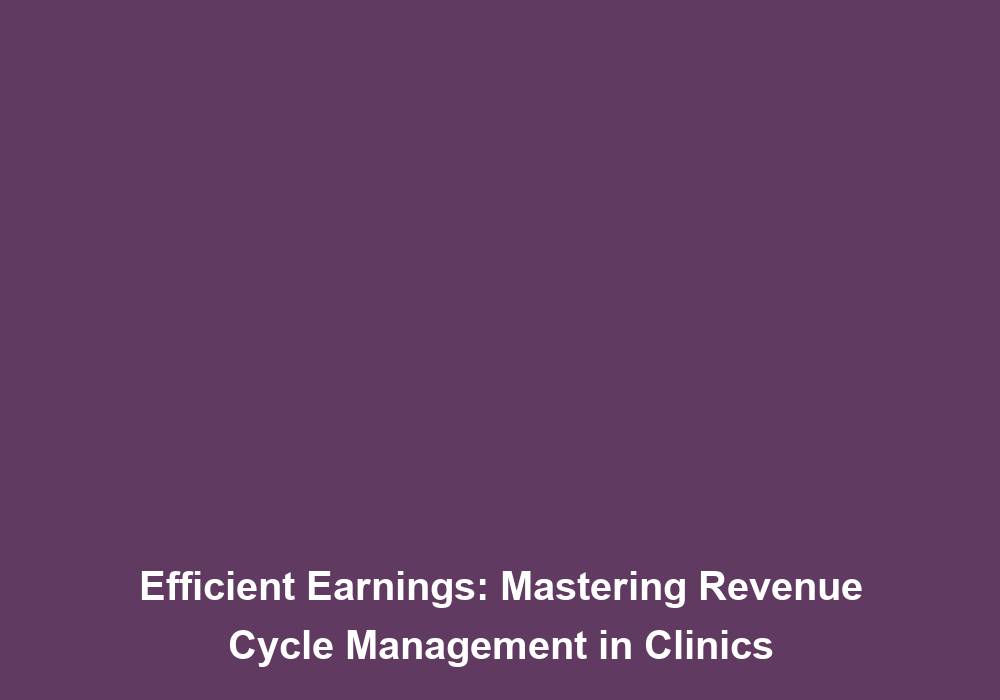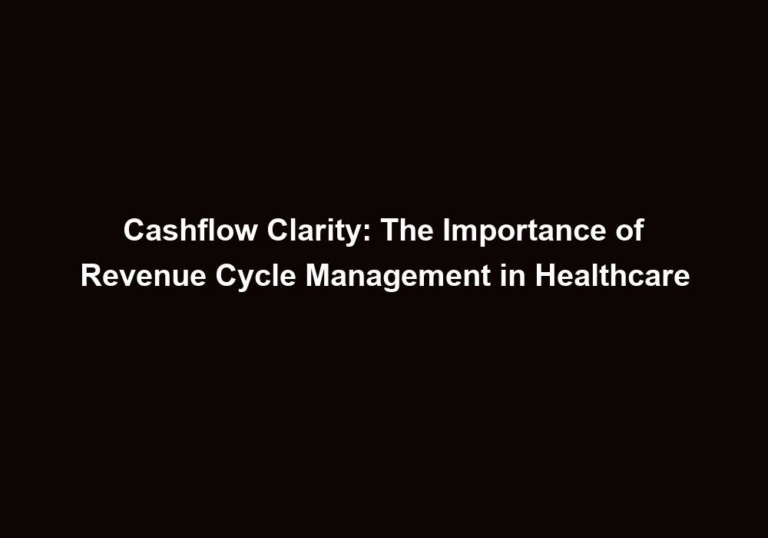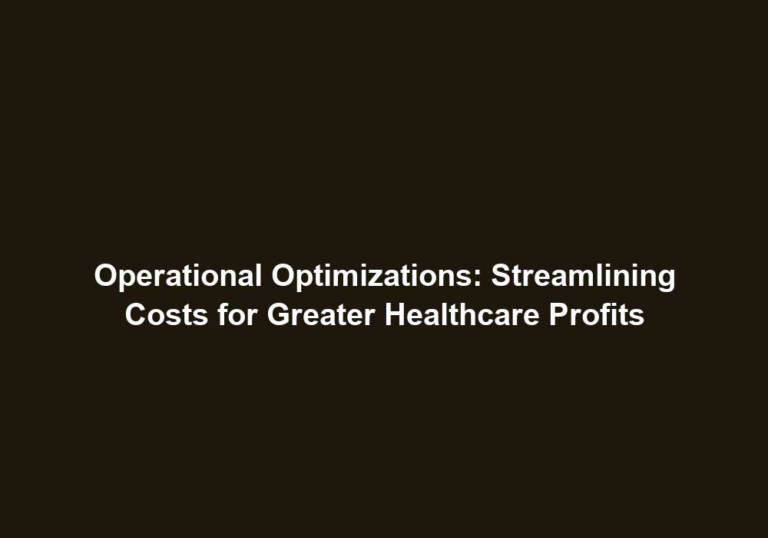Efficient Earnings: Mastering Revenue Cycle Management in Clinics
Revenue Cycle Management (RCM) plays a vital role in the financial success of clinics. It encompasses a series of steps aimed at maximizing revenue, reducing costs, and improving overall operational efficiency. By effectively managing the revenue cycle, clinics can optimize their earnings and ensure financial stability. In this article, we will delve into the various aspects of revenue cycle management and explore strategies to master it efficiently.
Understanding the Revenue Cycle
The revenue cycle in a clinic typically begins with patient registration and ends with the collection of payments for services rendered. It involves several key stages, each of which requires careful attention to detail and effective management.
- Patient Scheduling: Efficient revenue cycle management starts with accurate and timely patient scheduling. Clinics should have well-defined processes in place to ensure appointments are scheduled appropriately, minimizing gaps and ensuring optimal utilization of resources.
Effective patient scheduling is crucial for clinics to maximize their revenue. By implementing efficient appointment booking practices, clinics can minimize gaps in their schedules and ensure optimal utilization of resources. This can be achieved by using scheduling software that allows for easy appointment management, automated reminders, and real-time availability updates. Additionally, clinics can implement strategies such as grouping appointments by procedure type or provider expertise to further optimize their scheduling process.
- Insurance Verification: Verifying patients’ insurance coverage is crucial to avoid potential payment delays or denials. It is essential to confirm insurance eligibility, coverage limits, and pre-authorization requirements to prevent any financial surprises for both the clinic and the patient.
Insurance verification is a critical step in the revenue cycle management process. Clinics should implement a robust system for verifying patients’ insurance coverage to avoid payment delays or denials. This can be achieved by utilizing electronic eligibility verification tools that provide real-time information on patients’ insurance coverage, co-pays, deductibles, and pre-authorization requirements. By verifying insurance information upfront, clinics can proactively address any coverage issues, ensuring a smooth reimbursement process.
- Patient Check-In: Streamlining the check-in process is essential for a smooth revenue cycle. Collecting accurate demographic and insurance information during check-in ensures proper billing and minimizes claim rejections due to inaccurate data.
Efficient patient check-in is crucial for ensuring a smooth revenue cycle. Clinics should implement streamlined processes for collecting accurate demographic and insurance information during check-in. This can be achieved through the use of digital check-in systems that allow patients to input their information directly into the clinic’s electronic health record (EHR) system. By minimizing manual data entry and utilizing automated data validation tools, clinics can reduce the risk of claim rejections due to inaccurate patient information.
- Medical Coding and Documentation: Precise medical coding is essential for accurate billing and timely reimbursement. Clinics should ensure their coding practices comply with the latest industry standards and guidelines. Proper documentation of medical services provided is equally important to support the coding process and facilitate claim submission.
Accurate medical coding and documentation are crucial for maximizing revenue and minimizing claim denials. Clinics should invest in staff training to ensure their coding practices align with the latest industry standards and guidelines. This can be achieved through regular coding education sessions and ongoing monitoring of coding accuracy. Additionally, clinics should emphasize the importance of proper documentation to support the coding process. By implementing documentation best practices, such as thorough and detailed clinical notes, clinics can strengthen their claim submissions and increase the likelihood of timely reimbursement.
- Claim Submission: Timely claim submission is critical to ensure prompt reimbursement. RCM experts recommend submitting claims electronically whenever possible, as it reduces processing time and minimizes errors. Regular monitoring of claim status and prompt follow-up on any rejections or denials are essential to expedite payment.
Timely claim submission is key to optimizing revenue collection. Clinics should prioritize electronic claim submission whenever possible, as it reduces processing time and minimizes the risk of errors. Utilizing electronic claim submission software can streamline the process and provide real-time updates on claim status. Regular monitoring of claim status is crucial, and clinics should implement proactive follow-up procedures to address any rejections or denials promptly. By staying on top of claim status and taking necessary actions, clinics can expedite payment and minimize revenue delays.
- Payment Posting and Reconciliation: Accurate posting of payments received from insurance companies and patients is crucial. Regular reconciliation of payments against claims filed helps identify any discrepancies and facilitates the resolution of outstanding balances.
Accurate payment posting and reconciliation are essential for maintaining financial stability. Clinics should establish robust procedures for posting payments received from insurance companies and patients. This can be achieved through the use of automated payment posting software that integrates with the clinic’s billing system. Regular reconciliation of payments against claims filed is equally important to identify any discrepancies and resolve outstanding balances promptly. By implementing efficient payment posting and reconciliation processes, clinics can minimize revenue leakage and ensure proper financial management.
- Denial Management: Denials can significantly impact a clinic’s revenue cycle. An effective denial management process involves identifying the root causes of denials, addressing them promptly, and resubmitting claims with necessary corrections. Analyzing denial trends can provide valuable insights to prevent future denials.
Effective denial management is crucial for optimizing revenue and reducing financial losses. Clinics should implement a structured denial management process that includes identifying the root causes of denials, addressing them promptly, and resubmitting claims with necessary corrections. By analyzing denial trends, clinics can identify recurring issues and implement preventive measures to minimize future denials. This can be achieved through regular review of denial reports, staff training on common denial reasons, and proactive communication with payers to resolve any billing discrepancies.
- Patient Collections: Collecting patient payments, including copays, deductibles, and outstanding balances, is a crucial step in revenue cycle management. Establishing clear financial policies, offering flexible payment options, and effectively communicating with patients regarding their financial responsibilities can help improve collections.
Efficient patient collections are essential for clinics to optimize their revenue. Clinics should establish clear financial policies that outline patients’ responsibilities, including copays, deductibles, and outstanding balances. By providing transparent information and offering flexible payment options, such as payment plans or online payment portals, clinics can facilitate timely and convenient payment from patients. Effective communication with patients regarding their financial responsibilities is also key, and clinics should proactively educate patients on their insurance coverage and expected out-of-pocket costs. By prioritizing patient collections and implementing patient-friendly payment processes, clinics can improve their cash flow and overall financial stability.
Strategies for Efficient Revenue Cycle Management
To master revenue cycle management, clinics can implement the following strategies:
1. Implementing Technology Solutions
Utilizing modern technology solutions can streamline and automate various tasks involved in revenue cycle management. Electronic Health Record (EHR) systems with integrated billing modules allow for seamless data flow, reducing manual errors and improving efficiency. Additionally, practice management software can provide real-time insights into the revenue cycle, enabling timely interventions and decision-making.
By leveraging technology solutions such as electronic health record (EHR) systems and practice management software, clinics can enhance their revenue cycle management processes. EHR systems with integrated billing modules enable seamless data flow between clinical and billing systems, reducing the risk of manual errors and improving overall efficiency. Practice management software provides real-time insights into the revenue cycle, allowing clinics to identify bottlenecks or areas for improvement and make informed decisions. These technology solutions not only streamline tasks but also enhance data accuracy and facilitate effective decision-making.
2. Staff Training and Education
Properly training and educating staff members on revenue cycle management processes and best practices is essential. Regular training sessions can ensure that staff members are up-to-date with the latest coding guidelines, insurance regulations, and billing practices. This helps minimize errors, improve accuracy, and optimize revenue generation.
Investing in staff training and education is crucial for efficient revenue cycle management. Clinics should conduct regular training sessions to keep staff members informed about the latest coding guidelines, insurance regulations, and billing practices. This ensures that staff members are equipped with the necessary knowledge and skills to perform their roles effectively. By staying up-to-date with industry changes, clinics can minimize errors, improve accuracy in coding and billing processes, and ultimately optimize revenue generation.
3. Outsourcing Non-Core Functions
Outsourcing non-core revenue cycle management functions, such as medical coding and billing, can be a cost-effective solution for clinics. Partnering with specialized third-party service providers can ensure expert handling of these tasks while allowing the clinic’s staff to focus on core patient care activities.
Outsourcing non-core revenue cycle management functions can provide clinics with several benefits. By partnering with specialized third-party service providers, clinics can leverage their expertise in medical coding, billing, and claims management. This allows clinics to allocate their internal resources more efficiently, focusing on core patient care activities. Outsourcing also offers cost savings, as clinics can avoid the expenses associated with hiring and training additional staff for these functions. Furthermore, specialized service providers often have access to advanced technology and industry best practices, leading to improved operational efficiency and revenue optimization.
4. Monitoring Key Performance Indicators (KPIs)
Establishing and tracking key performance indicators (KPIs) is crucial for assessing the effectiveness of revenue cycle management efforts. KPIs such as denial rates, days in accounts receivable, and collection rates provide valuable insights into the clinic’s financial health and can help identify areas for improvement.
Monitoring key performance indicators (KPIs) is essential for evaluating the success of revenue cycle management efforts. Clinics should establish a set of KPIs that align with their financial goals and regularly track and analyze these metrics. Examples of KPIs that can provide valuable insights include denial rates, which indicate the effectiveness of claim submission and follow-up processes; days in accounts receivable, which measure the speed of payment collection; and collection rates, which reflect the clinic’s ability to collect patient payments. By monitoring these KPIs, clinics can identify areas for improvement and implement targeted strategies to optimize their revenue cycle management.
5. Regular Auditing and Compliance
Regular internal audits and compliance checks are important to identify any potential compliance issues or coding errors. By conducting periodic audits, clinics can proactively address any discrepancies, rectify errors, and ensure adherence to industry regulations, avoiding penalties and improving revenue flow.
Regular auditing and compliance checks are crucial for maintaining regulatory compliance and minimizing financial risks. Clinics should conduct internal audits to review coding accuracy, billing practices, and adherence to industry regulations. This helps identify any potential compliance issues or coding errors, allowing clinics to take corrective actions promptly. By rectifying errors and ensuring compliance with industry regulations, clinics can avoid penalties and minimize revenue disruptions. Regular auditing also promotes continuous improvement and ensures that revenue cycle management processes are optimized for maximum efficiency and effectiveness.
6. Enhancing Patient Engagement
Engaging patients in the revenue cycle management process can promote transparency and improve collections. Clear communication of financial responsibilities, providing cost estimates, and offering convenient payment options can empower patients to take an active role in managing their healthcare expenses, resulting in improved revenue for the clinic.
Enhancing patient engagement is key to optimizing revenue collection and improving the overall patient experience. Clinics should prioritize clear communication with patients regarding their financial responsibilities, including copays, deductibles, and out-of-pocket costs. This can be achieved through patient-friendly billing statements that provide detailed information on services rendered and associated costs. Additionally, clinics should offer cost estimates upfront, allowing patients to anticipate their financial obligations and plan accordingly. Offering convenient payment options, such as online payment portals or payment plans, can further empower patients to take an active role in managing their healthcare expenses. By promoting transparency and engaging patients in the revenue cycle management process, clinics can improve collections and foster positive patient relationships.
In conclusion, mastering revenue cycle management is essential for clinics to optimize earnings and ensure financial stability. By understanding the revenue cycle stages and implementing effective strategies, clinics can streamline processes, minimize errors, and improve overall operational efficiency. Embracing technology, investing in staff training, and focusing on patient engagement are key pillars to achieving efficient revenue cycle management.







